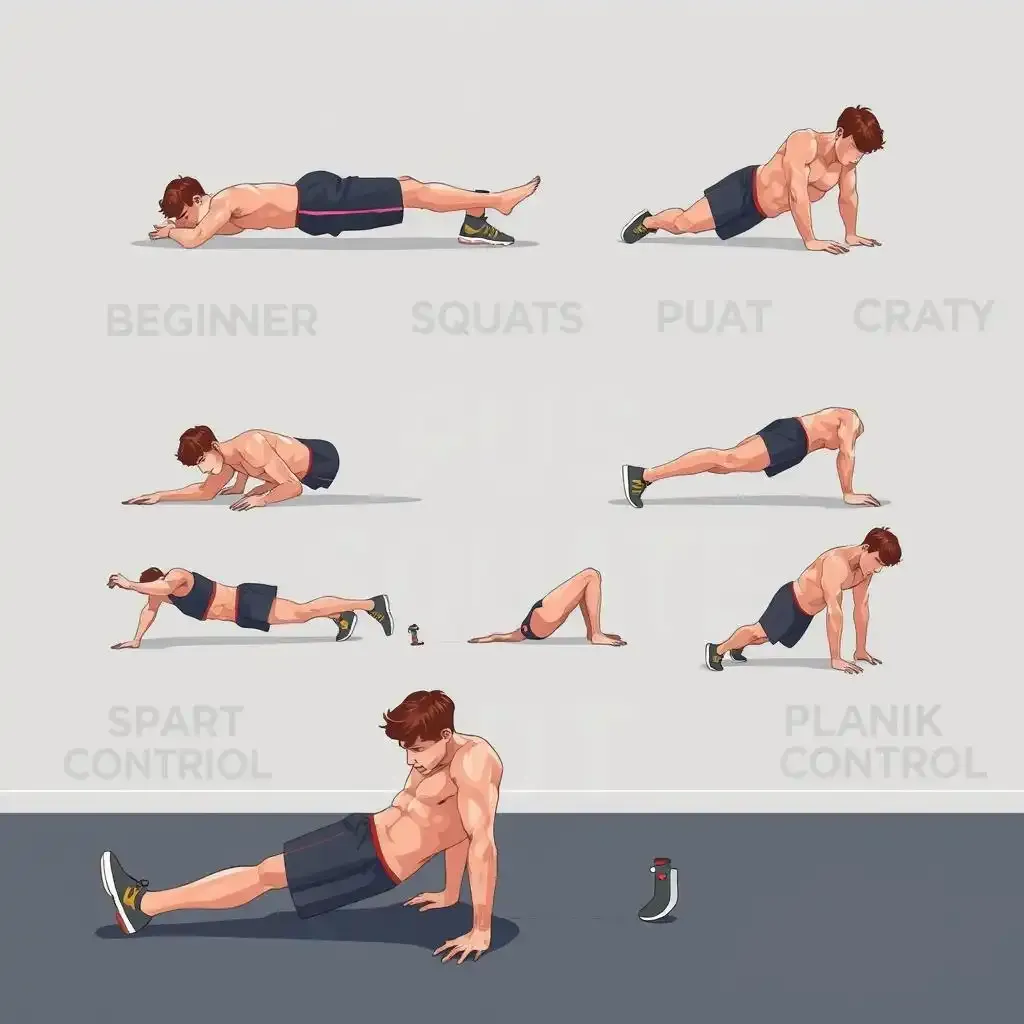Table of Contents
Ready to ditch the gym and sculpt your dream physique using only your bodyweight? Welcome to the world of calisthenics! A calisthenics exercise routine is a fantastic way to build strength, endurance, and flexibility, all without expensive equipment. At kizworld, we believe that fitness should be accessible to everyone, and calisthenics is the perfect example of this philosophy. This comprehensive guide will walk you through creating a personalized calisthenics exercise routine, catering to all fitness levels, from beginner to advanced. We'll explore a variety of exercises, progression techniques, and strategies to ensure you build a sustainable and effective workout plan that keeps you motivated and seeing results. Get ready to free your inner strength and launch on a process to a healthier, fitter you!
Routine Type | Description | Skill Level | Example Exercises |
|---|---|---|---|
Beginner | Focuses on fundamental movements and building a base level of strength and endurance. | Beginner | Squats, Push-ups (on knees if needed), Walking Lunges, Plank |
Intermediate | Introduces more challenging variations of basic exercises and incorporates more complex movements. | Intermediate | Standard Push-ups, Incline Push-ups, Diamond Push-ups, Jump Squats, Burpees |
Advanced | Emphasizes advanced calisthenics movements, requiring significant strength and control. | Advanced | Handstand Push-ups, Muscle-ups, L-sits, Pistol Squats, Planche |
Hybrid | Combines various exercises to work multiple muscle groups simultaneously. | Beginner-Advanced (adaptable) | Circuit training incorporating push-ups, squats, lunges, planks, etc. |
Crafting Your Perfect Calisthenics Exercise Routine
Okay, so you're thinking about diving into calisthenics – awesome! It's like a superpower you build yourself. No fancy equipment needed, just you, your body, and maybe a park bench. But building a *perfect* routine isn't about copying someone else's; it's about understanding what *your* body can handle and gradually pushing it further. Think of it like building a LEGO castle – you start with the basics (squats, push-ups), then add more complex pieces (dips, pull-ups) as you get stronger. Don't try to build a skyscraper on day one! Start small, be consistent, and watch your strength grow. It's incredibly rewarding to see how far you've come, and it's all thanks to your own hard work.
Exercise | Sets | Reps | Rest |
|---|---|---|---|
Squats | 3 | 10-12 | 60 seconds |
Push-ups (on knees if needed) | 3 | As many as possible (AMRAP) | 60 seconds |
Plank | 3 | 30-60 seconds | 60 seconds |
One thing I learned the hard way? Proper form is everything! It's way better to do fewer reps with perfect form than tons of reps with sloppy form. Sloppy form leads to injuries – trust me, I've been there. It's like trying to build that LEGO castle with wonky bricks – it’s gonna fall apart! Watch videos, maybe even ask a friend or trainer to check your form. There are tons of free resources online that can help you perfect your technique. It's an investment in your body and prevents those frustrating setbacks.
- Start with 2-3 workouts per week.
- Focus on mastering the basics before moving to advanced exercises.
- Listen to your body! Rest when you need to.
- Don't compare yourself to others. It's your process.
Remember, consistency is key. Think of it like watering a plant – you won't see results overnight, but with regular effort, you'll see amazing growth. Don't get discouraged if you don't see immediate results. Celebrate small victories – maybe you added an extra rep, or held a plank for a few seconds longer. Every little bit counts! Also, mix it up! Your body adapts quickly, so change your routine every few weeks to keep challenging yourself. This prevents plateaus and keeps things exciting.
I know what you might be thinking: "But what if I get bored?" That's where the fun part comes in! Calisthenics is incredibly versatile. You can do it anywhere – at home, in a park, even on a beach! There's always something new to learn, new variations to try. Try adding some different exercises, or incorporating elements from other fitness styles. The possibilities are endless! Think of it as an exploration, not a chore.
Workout Day | Focus | Example Exercises |
|---|---|---|
Monday | Upper Body | Push-ups, Dips, Handstand practice (against a wall) |
Wednesday | Lower Body | Squats, Lunges, Glute Bridges |
Friday | Core & Flexibility | Plank variations, leg raises, stretching |
Calisthenics Exercise Routine: Beginner to Advanced Progressions
Calisthenics Exercise Routine Beginner To Advanced Progressions
Starting Strong: Your Beginner Calisthenics Process
So, you're ready to let loose your inner superhero? Fantastic! Calisthenics is all about building strength using your own bodyweight. It's like a personalized gym that goes everywhere with you. For beginners, it's crucial to focus on mastering the basics. Think of it like learning to ride a bike – you wouldn't try a wheelie before you can even balance! Start with simple exercises like squats, push-ups (on your knees if regular push-ups are too tough), and planks. Aim for good form over a massive number of reps. Imagine building a tower of blocks – a wobbly base will make the whole thing collapse! Perfecting your form prevents injuries and sets you up for success. Three workouts a week are a great starting point. Don't push yourself too hard; listen to your body, and rest when needed.
Exercise | Sets | Reps/Hold | Rest |
|---|---|---|---|
Squats | 3 | 10-12 | 60 seconds |
Push-ups (modified if needed) | 3 | As many as possible (AMRAP) | 60 seconds |
Plank | 3 | 30-60 seconds | 60 seconds |
Level Up: Intermediate Calisthenics Moves
Once you've mastered the beginner exercises, it's time to level up! This is where things get more exciting. You'll start adding variations to your exercises to increase the challenge. Think of it as adding extra floors to your block tower! For example, you might progress from regular push-ups to incline push-ups (easier) or decline push-ups (harder). With squats, you could add jump squats for an explosive boost. Plank variations like side planks or forearm planks will work your core in new ways. Remember, consistency is key. Even small improvements add up over time. Don't be afraid to try new things, but always prioritize good form. If something feels wrong, stop and reassess. Your body will thank you!
- Incline push-ups (hands on a bench)
- Decline push-ups (feet elevated)
- Jump squats
- Side planks
- Walking lunges
Advanced Calisthenics: Reaching New Heights
Reaching the advanced level in calisthenics is a testament to your dedication and hard work. At this point, you'll be tackling some seriously impressive moves! Think muscle-ups (combining a pull-up and a dip), handstand push-ups, and even the legendary planche! It's like building a castle with intricate details and hidden passages. This stage requires significant strength, balance, and control. You'll need to focus on progressive overload – gradually increasing the difficulty of your exercises. This might involve adding weight (using a weighted vest), increasing reps, or trying more challenging variations. Remember, even at this level, proper form is paramount. It’s easy to get caught up in the thrill of advanced moves, but rushing can lead to injury. Take your time, be patient, and celebrate your achievements along the way. You've earned them!
Building a Sustainable Calisthenics Exercise Routine for LongTerm Success
Building A Sustainable Calisthenics Exercise Routine For Longterm Success
Listen to Your Body: The Importance of Rest and Recovery
Okay, so you've been smashing your calisthenics workouts – high five! But even superheroes need downtime. Think of your muscles like a sponge. You can't keep soaking it up with water (workouts) without letting it dry out (rest) sometimes. Ignoring rest leads to overtraining, which is like trying to build a sandcastle during a hurricane – it'll just crumble! Overtraining can lead to injuries and burnout. You'll lose motivation faster than a toddler loses interest in a toy. Aim for at least one rest day per week. Your body needs time to recover and rebuild stronger. It's not lazy; it's strategic. Listen to your body; it's smarter than you think! If you're feeling unusually sore or tired, take an extra rest day. It's not a sign of weakness; it's a sign of intelligence. Trust me; your future self will thank you.
Day | Workout | Rest |
|---|---|---|
Monday | Calisthenics | Rest |
Tuesday | Rest | Rest |
Wednesday | Calisthenics | Rest |
Thursday | Rest | Rest |
Friday | Calisthenics | Rest |
Saturday | Rest | Rest |
Sunday | Rest | Rest |
Progressive Overload: The Secret to Constant Growth
So, you're crushing your workouts, feeling strong, and maybe even starting to think you're invincible? Fantastic! But here's the thing: your body is a super-smart machine. It adapts quickly. If you keep doing the same exercises with the same number of reps, it'll eventually plateau. It's like trying to teach a dog new tricks by repeating the same command endlessly – eventually, the dog will just yawn and look away. To keep making progress, you need to progressively overload your muscles. This means gradually increasing the difficulty of your workouts. You can do this by adding more reps, sets, or trying more challenging variations of exercises. You could also increase the time you hold a plank or add a weighted vest. It's all about pushing your limits slowly but surely. Think of it as climbing a mountain – you don't reach the summit in one leap! You take it one step at a time. You'll be amazed at how much stronger you'll become. It’s like watching a plant grow – slow and steady wins the race. Be patient, and enjoy the progression. It's your journey!
- Increase reps by 2-3 each week
- Add an extra set to your workout
- Try a more challenging variation of an exercise (e.g., incline to decline push-ups)
- Increase the time you hold an isometric exercise (e.g., plank)
- Incorporate weighted calisthenics
Final Thought
Creating the right calisthenics exercise routine is a trip, not a race. Remember to listen to your body, prioritize proper form, and celebrate your progress along the way. With consistency and the right approach, you can achieve amazing results with calisthenics. So, grab your workout gear, find your space, and start building the body you've always dreamed of. Happy training!